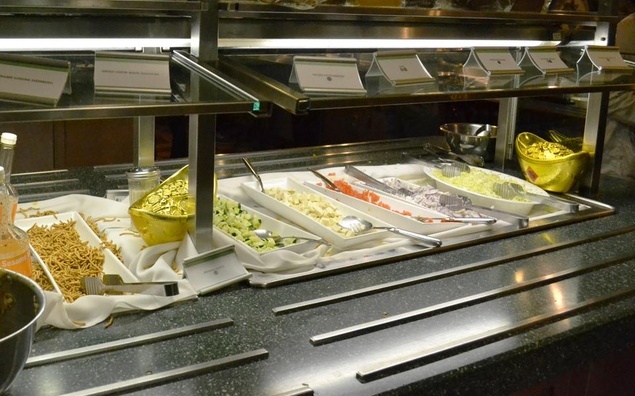
Techno-HUDS: College Dining in the Digital Age
Ever wonder when the buttermilk chicken will be served again? Or why there’s cottage cheese every morning, but strawberries only a few times each week? Harvard University Dining Services has answers to these questions. It’s a fairly high-tech process: HUDS tracks which foods are eaten and when, analyzes the popularity data for each dish, performs inventory, purchases ingredients, and monitors the expenditures of every dining hall.
Of all the ways HUDS uses technology, students are the most familiar with the swipe system: College students must swipe their Harvard ID every time they eat in a dining hall. This system allows HUDS to “cook to the next 15 minutes”––project how many people are about to arrive, then cook to feed that number.
“There aren’t a lot of types of foods that are made all at once, because then it just sits in a warmer. We want food that is served at its freshest,” Crista Martin, Director of Strategic Initiative and Communications at HUDS, says.
This data collected by the swipe system goes into a database called FoodPro. In addition to storing swipe data, FoodPro retains all 5000 or so recipes and all of the required ingredients, which are also linked to their various vendors. Whenever HUDS creates a new recipe, they add the ingredients to the system.
FoodPro also tracks “acceptability factors,” which are notes on dish popularity.
“There’s a sort of common misperception—we often get feedback from a student that says ‘nobody likes x.’ But we wouldn’t serve it if nobody liked it!” Martin says. “We do in fact have this computer keeping track of it, so maybe you particular student don’t like it, but there’s always someone who likes it.”
When HUDS serves a dish for the first time, the number of servings prepared is based on HUDS’ best guess. But each time it is served thereafter, the system projects how much of the dish should be prepared based on how much was consumed the last few times it was served.
Every week, the chefs get together and review this data. “Everyone [HUDS staff, management, the chefs, and so on] has a role in what’s happening,” Martin explains. “FoodPro is how we order, inventory, and prepare, so everyone is engaged with it at some level.”
For example, HUDS partners with the company Red’s Best, a Boston-based seafood wholesaler that works with approximately 1,000 local fisherman to supply fish that is fresh and in season. Even though HUDS never knows exactly what type of fish they’re going to get, they usually have a rough idea of how much they need. HUDS logs the number of pounds of fish they use each time this fish is served, and FoodPro processes this data.
In 2015, when HUDS first initiated this partnership, Red’s Best fish was only served in the dining halls on Fridays at lunch. Now, because of its popularity, it’s served Wednesdays at dinner as well.
Controlling numbers is also important when it comes to grill orders. Here, the issue is with abandoned orders. Before the 2016-2017 school year, all grill orders were done on paper slips. “The issue with the paper slips was that people forgot about their grill order. They’d order something off the grill, and then get food elsewhere, and not come back,” Martin says.
Now, students in the upper class houses can order customized food on iPads and a mobile application. This new system, first piloted at the Quad dining halls and then introduced in all houses last year, has greatly reduced the number of abandoned orders by sending students a notification when their food is ready.
Grill data also gives insight on other menu items. “We look at this data. When the grill is busy it might mean that the main entree was not a hit, so sometimes we make adjustments based on that,” Martin says.
Additionally, for the first time this year, HUDS has incorporated texting into their feedback channels, which had already consisted of cards in the dining hall, emails, and social media outlets. Students can text a five-digit number (55744) with a comment that includes specific location keyword (for example, “Berg” for Annenberg) and are guaranteed to receive a reply within twenty-four hours.
Martin believes that while students are more likely to use email to say what they don’t like, they tend to talk more about what they do like through text because of its relative ease.
“Texting is so easy and so instantaneous and you can jump on your phone when you’re right there on the table, so we’re getting more about the good stuff, and not just a few one-off comments about something that someone didn’t like,” she says. “So that’s been awesome, because it gives more information on what your tastes are.”


